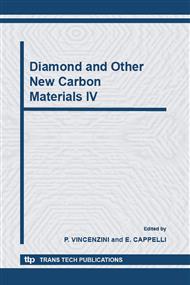p.67
p.73
p.77
p.83
p.93
p.103
p.113
p.119
p.127
Surface Conductivity of Diamond: A Novel Doping Mechanism
Abstract:
One of the most amazing features of diamond is the p-type surface conductivity which occurs when intrinsic material is hydrogen terminated and brought into contact with appropriately chosen adsorbates. Experiments during the last decade have revealed the different roles of the surface acceptors and of the covalent carbon-hydrogen surface bonds: providing unoccupied electronic states, and lowering the energy barrier for electron transfer from the diamond, respectively. The simplest and historically first method to supply surface acceptors, i.e. exposing hydrogenated diamond to air, provides, unfortunately, the most complex electronic system acting as surface acceptors, namely solvated ions within atmospheric wetting layers. In that case electron transfer is accompanied by a red-ox reaction that finally induces the hole accumulation. A much simpler case of transfer doping has been demonstrated for C60F48 as molecular surface accpeptors. In this case, the doping yield as a function of surface coverage can be modelled quantitatively by the transfer doping mechanism. Also, pure C60 can be adopted for transfer doping, but the formation of the van-der-Waals solid is required in this case to circumvent the electron correlation energy for charge transfer to a single fullere cage. The C60 layers can be stabilized by oxygen-mediated polymerisation without loosing their doping efficiency.
Info:
Periodical:
Pages:
93-102
Citation:
Online since:
October 2006
Authors:
Keywords:
Price:
Сopyright:
© 2006 Trans Tech Publications Ltd. All Rights Reserved
Share:
Citation:


